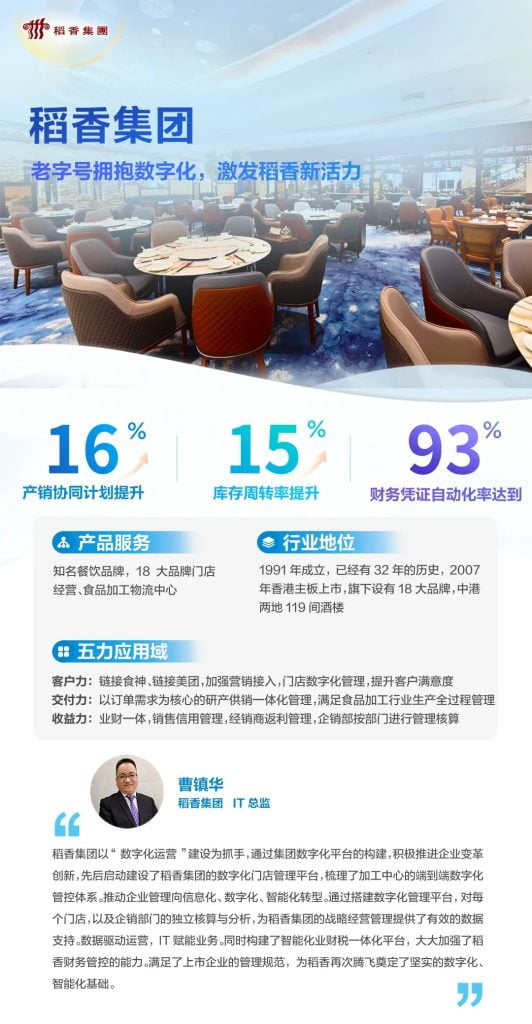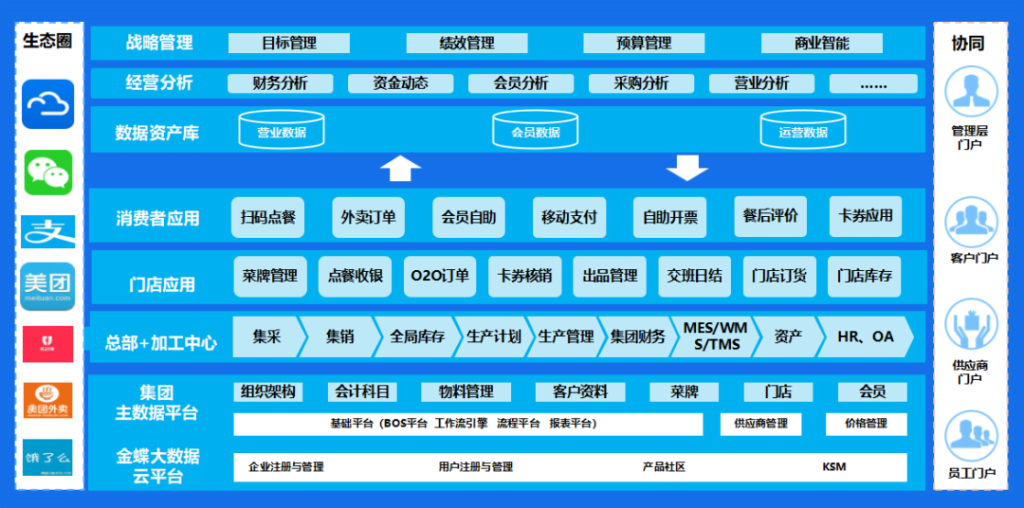
Corporate profile
Established in 1991, Tao Heung Group has grown into a vast network of over 110 restaurants and bakeries. The group has successfully adopted a diversified branding strategy, operating 18 distinct brands, each offering unique culinary styles. These brands are spread across Hong Kong and the South China region, solidifying Tao Heung’s presence in the market.

Tao Heung Group is the first Chinese catering group in Hong Kong to establish its own food processing and logistics centers. In 2007, the group opened a food processing and logistics center in Dongguan, offering more diversified and large-scale processing services compared to its original center in Fo Tan.
In December 2010, the Tai Po Food Processing and Logistics Center officially began operations. Its production capacity is five times that of the original Fo Tan center, providing a wider range of food processing and logistics distribution services. The facility is equipped with laboratories meeting both national and international standards, ensuring the delivery of safe, high-quality food to customers.
Together with the Dongguan logistics center, Tao Heung Group’s facilities boast the capacity to support the development of up to 250 outlets across Hong Kong and Mainland China, demonstrating its commitment to operational excellence and food safety.
Through its multi-brand strategy and differentiated competition, Tao Heung Group has successfully positioned itself as a leader in the catering industry. By establishing its own food processing and logistics centers, the group has effectively reduced costs, enhanced product quality, and ensured a competitive edge. These efforts enable Tao Heung to achieve sustainable growth and pave the way for the company’s next chapter of success and prosperity.
Digital Transformation Requirements
Transformation Insights: A Digitalized “Three-in-One” Concept for Headquarters + Restaurant Outlets + Processing Centers
The Tao Heung Group, with a vast network of over 110 restaurants and bakeries spread across Hong Kong and the South China region, operates through a dual-headquarters model with offices in both Hong Kong and Dongguan. Through a multi-brand strategy, the group has achieved outstanding success in the food and beverage industry. At the same time, Tao Heung Group is a Chinese catering group that owns food processing and logistics centers.
This setup enables centralized procurement, food processing, and strict quality control, providing high-quality products to consumers while significantly improving operational and cost efficiency.
Currently, however, there is a lack of effective coordination among the headquarters, restaurant outlets, and processing centers. End-to-end processes are not streamlined, leading to inefficiencies and high operational costs. To address these challenges, a digitalized management environment that integrates the headquarters, restaurant outlets, and processing centers into a collaborative, three-in-one digital ecosystem has emerged as a solution.
Tao Heung Group’s digitalization strategy primarily focuses on the integration of a unified group platform, digital management of food processing centers, supply chain collaboration between restaurant outlets and processing centers, digital control of restaurant operations, and intelligent group operations.
By implementing and upgrading through a digital platform, the group can better empower its business objectives, positioning itself as a shining star in the food and beverage industry.
➤1 Siloed Structure and Information Islands
Tao Heung Group plans to establish a unified digital management platform that integrates the headquarters, restaurant outlets, and processing centers to enable highly efficient cross-organizational collaboration across different locations. Currently, the existing information systems are fragmented, making it impossible to respond quickly or collaborate efficiently. Communication between restaurant outlets and processing centers regarding stock requests is delayed, preventing the processing centers from achieving better production-sales coordination. The digital system in the processing centers lacks end-to-end process integration. Tasks such as material planning still rely heavily on manual work, food quality data is not well collected, and tracking production progress is challenging. Headquarters financial personnel need to access multiple systems to verify data and manually reconcile financial accounts, which reduces business empowerment and limits control over operational risks.
As a result, Tao Heung Group’s IT Director emphasized that building an integrated group platform for cross-organizational collaboration has become the foundation for this digital transformation. Without such a platform, it would be like “water without a source or a tree without roots.”
➤2 Restaurant Operations: Difficult to Manage, Low Efficiency
In 2017, the restaurant outlets implemented Kingdee Cloud·Galaxy for procurement, inventory, and stock accounting applications. However, there is no system support for managing the inputs, outputs, and cost consumption of the central kitchen operations at the restaurant level. Calculating costs for the restaurant outlets is challenging, and data related to product yield and ingredient waste is difficult to track. Additionally, there is an information asymmetry between the restaurant outlets and the headquarters’ processing centers, resulting in delayed feedback and low collaboration efficiency.
As a solution, there is an urgent need for an integrated platform to enable the digitalized operations of the restaurant outlets. This platform should also connect the outlets with the processing centers and headquarters, ensuring timely and efficient information flow. By creating a seamless business cycle, this system would enhance cross-organizational collaboration efficiency.
➤3 Cost analysis is complex, tax coordination is challenging, and budget management is weak.
Due to the unique nature of the industry, cost accounting for restaurant outlets must calculate costs based on food recipes and ingredient usage rules. Without system support, this process relies on manual intervention, significantly impacting accuracy and timeliness. With numerous outlets in South China, the workload for cost accounting is immense, making it difficult to gain insights into the operational performance of each outlet. Similarly, food processing costs at the processing centers are manually calculated, and the order fulfillment process lacks end-to-end integration, leading to low overall efficiency. Enhancing the digital management capabilities of the food processing centers is a core focus of this plan.
This project also aims to strengthen integration with tax systems, creating a data closed-loop to achieve efficient financial and tax coordination. Through the implementation of the budgeting module, the project will streamline budgeting processes, establish control checkpoints, and improve the group’s budget management capabilities.
➤4 Analysis of the Current State of Information Systems
Strategic Level: The current information systems struggle to support the company’s “Headquarters + Restaurant Outlets + Processing Center Integration” operational management requirements;
Business Level: Insufficient collaboration among business units, lack of end-to-end integration in the value chain, and the need for further improvement in business process systems;
Application Level: Some heterogeneous systems are not integrated, resulting in severe information silos, weak system integration, and low levels of automation;
IT Organization Level: Lack of top-level IT planning, with ERP applications of various departments operating independently and fragmented, hindering collaboration and making centralized management difficult;
The current information system applications are ineffective, with a significant reliance on manual offline operations, making it impossible to achieve end-to-end management based on the group’s business-finance integration. This falls far short of the envisioned digitalization strategy. Based on the above, the digital transformation of Tao Heung Group is imperative.
Digital Transformation Solution
➤ Group Integration + Agile Collaboration + Smart Operations
Under the guidance of the digital transformation strategy, establishing a group-wide integrated digital management platform is crucial for Tao Heung Group to overcome operational challenges. By developing a tailored digital application architecture, the group achieves unified applications, efficient cross-organizational collaboration, and end-to-end closed-loop processes. Through continuous refinement of the digital blueprint, Tao Heung Group will realize digitalized group management, enhance agile collaboration efficiency, and achieve smart operations. Supported by Kingdee Cloud Galaxy, the group gains an end-to-end closed-loop application framework and a comprehensive management blueprint to drive its digital transformation.

➤1 Digital Platform: Unified System Platform and Master Data Governance Framework
To support Tao Heung Group’s multi-organization and multi-location operational model, a robust digital platform must be established. This platform will enable unified management of data across multiple organizations by creating a centralized data center, ensuring seamless information sharing and integration within the group. It will also facilitate cross-organizational collaboration for project execution, providing a reliable digital foundation for upgrading the group’s management capabilities.
A centralized accounting system will be implemented with standardized accounting practices, laying a solid foundation for consolidated financial reporting across the group. The governance and unification of master data are critical to ensuring consistent and efficient group operations. As the saying goes, “building roads with unified tracks enables smooth operations”—standardized master data management will serve as the cornerstone of streamlined, integrated group operations. This digital platform will drive Tao Heung Group’s transition to a modern, efficient, and highly collaborative management model.
➤2 Digitalized Operations: Processing Center Digital Operation Management
Tao Heung Group’s current processing center information system, in use for nearly a decade, has become disconnected from evolving business processes, control mechanisms, and modern management needs, worsened by frequent staff turnover that has degraded system usage quality. Sales demand integration is fragmented across multiple inconsistent entry points without a unified, scenario-based process, while production planning remains manual, resulting in low control and inefficiency. The lack of effective management for material inputs and production outputs, combined with incomplete records, makes accurate input-output tracking impossible, leading to imprecise product cost calculations based on rough approximations. To address these issues, Tao Heung Group must modernize its system with a centralized sales demand portal, automated production planning, digitalized input-output tracking, and precise cost management to enhance efficiency, traceability, and profitability while aligning operations with current business demands.
This project aims to achieve end-to-end process integration, with a focus on establishing key process systems including sales-to-receivables, procurement-to-payables, inventory management, raw materials-to-finished products, quality management, and cost accounting. These processes have been comprehensively streamlined and implemented through the Xingkong system, completing the full digital management of the processing center. This has effectively improved the accuracy of planning at the processing center, enabling a quick response to rapidly changing market demands while strengthening control over the food processing workflow. It ensures the effective digital operation of Tao Heung Group’s processing centers, guaranteeing production progress, quality, and the calculability and controllability of food processing costs. Additionally, it enables the digital management of restaurant outlets, with the system automatically calculating outlet costs.
➤3 Digitalized Finance: Automated Accounting – Integration of Business, Finance, and Tax
Constructing an integrated management platform for Tao Heung Group enables unified management of multiple organizations through a centralized data center. This platform achieves the integration of business and finance, particularly by leveraging the system to complete cost accounting and analysis, significantly improving financial accounting efficiency while ensuring consistency between business and financial operations. Finance can trace back to business activities, enabling better risk control during operations and minimizing enterprise risks. Specifically, tailored to Tao Heung Group’s multi-outlet operational model, the platform achieves store-level accounting and integrated business-finance management, providing clear insights into each store’s profit and loss while effectively monitoring store costs. This improves Tao Heung Group’s financial accounting efficiency and operational oversight, ensuring the healthy operation of its outlets. By gaining visibility into each store’s profitability, the platform significantly reduces operational risks across all outlets.
By connecting with tax systems, Tao Heung Group has successfully achieved true integration of business, finance, and tax, significantly improving invoicing efficiency at store level while reducing workload. The implementation of intelligent invoicing and receipt management applications has enabled the group to establish a fully digitalized tax management capability. This not only streamlines tax-related processes but also enhances operational efficiency and ensures compliance, marking a significant step forward in Tao Heung Group’s journey toward comprehensive digital transformation.
➤4 Digitalized Management: Building a Digital Management Platform for Restaurant Outlets
Building a digitalized operations management platform for restaurant outlets has enabled effective management of order requests from restaurant outlets to the processing center. This has significantly improved logistics coordination between outlets and the processing center, enhancing overall efficiency. Moreover, the platform provides a solid data foundation for the processing center’s production and sales planning, ensuring smoother operations and alignment of supply with demand.
At the same time, the implementation of Kingdee’s “Food Solution” has streamlined the daily operational management of restaurant outlets. The system automatically calculates outlet costs, greatly improving the accuracy and timeliness of cost accounting. This ensures that financial data is reliable and readily available for better decision-making.
The platform also offers clear operational data reports, providing an in-depth understanding of each outlet’s performance. It allows for transparent insights into the profit and loss situation of individual outlets, enabling restaurant managers to assess and optimize their operations effectively.
The Value of Digital Transformation
Tao Heung Group, a leader in the restaurant industry, has established a differentiated competitive advantage through its multi-brand business strategy and the service capabilities of its self-managed and controlled food processing centers. Through its digitalization strategy, the group has built strong digital combat capabilities.
Stronger Customer Acquisition Capability:
The digital marketing system integrates with platforms such as Meituan and Food God, achieving seamless online and offline integration. This has effectively supported the growth in both order volume and customer base while enhancing customer satisfaction.
It also enabled the group to streamline internal sales and external customer sales management, covering the entire process from order placement, shipment notification, warehousing, receivables, payment collection, to invoicing. Additionally, the system manages channel rebates, customer credit, and pricing controls on the sales side, fostering collaboration with distribution channels to jointly capture the restaurant market.
Stronger Delivery Capability:
The digital supply chain streamlines front-end sales demand entry points and manages them by scenarios. The processing center is able to coordinate sales demands from all different channels and develop comprehensive production and sales plans based on these demands. This significantly enhances the center’s planning and production-sales coordination capabilities.
Through effective management of the food processing workflow, input and output data are accurately collected, and cost calculations are automatically performed within the system. By comprehensively optimizing the end-to-end processes of the processing center, the entire order delivery process is effectively managed, improving order delivery efficiency and enhancing the overall digitalized operational capacity of the processing center.
Higher Profitability:
The implementation of a multi-organization financial system enables unified and standardized management of business and financial operations. While meeting the accounting requirements for each legal entity within the group, it also fulfills the needs of internal management accounting. Due to the company’s internal management requirements, the Marketing Department is required to conduct independent accounting.
For sales transactions handled by the Marketing Department, internal settlement prices must be set for internal transactions with Wan Hao Logistics. At the same time, internal management profit statements for Wan Hao and profit statements for the Marketing Department are generated to reflect the true profitability of the sold products.
Issues surrounding inter-organizational business processing and reconciliation are no longer a headache. The complex process of consolidating group financial statements is now more easily configured, significantly enhancing the economic efficiency of the Tao Heung Group.































